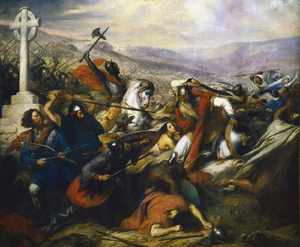
Back Slag van Poitiers Afrikaans معركة بلاط الشهداء Arabic معركة بواتييه ARZ Poitiers meld (732) (trutca ke Charles de Steuben) AVK Puatye döyüşü (732) Azerbaijani پواتیه دؤیوشو (۷۳۲) AZB Бітва пад Турам (732) Byelorussian Битка при Поатие Bulgarian তুরের যুদ্ধ Bengali/Bangla Batalla de Poitiers (732) Catalan
| Battle of Tours | |||||||
|---|---|---|---|---|---|---|---|
| Part of the Umayyad invasion of Gaul | |||||||
 Charles de Steuben's Bataille de Poitiers en octobre 732 romantically depicts a triumphant Charles Martel facing Abd Al Rahman Al Ghafiqi at the Battle of Tours. | |||||||
| |||||||
| Belligerents | |||||||
| Umayyad Caliphate[1] | |||||||
| Commanders and leaders | |||||||
| Abd al-Rahman al-Ghafiqi[1] † | |||||||
| Strength | |||||||
| 15,000–20,000[1] | 20,000[1] | ||||||
| Casualties and losses | |||||||
| 1,000[1] | 12,000[1] | ||||||
The Battle of Tours,[6] also called the Battle of Poitiers and the Battle of the Highway of the Martyrs (Arabic: معركة بلاط الشهداء, romanized: Maʿrakat Balāṭ ash-Shuhadā'),[7] was fought on 10 October 732, and was an important battle during the Umayyad invasion of Gaul. It resulted in victory for the Frankish and Aquitanian forces,[8][9] led by Charles Martel, over the invading Muslim forces of the Umayyad Caliphate, led by Abd al-Rahman al-Ghafiqi, governor of al-Andalus. Several historians, such as Edward Gibbon, have credited the Christian victory in the battle as an important factor in curtailing the Islamization of Western Europe.[10]
Details of the battle, including the number of combatants and its exact location, are unclear from the surviving sources. Most sources agree that the Umayyads had a larger force and suffered heavier casualties. Notably, the Frankish troops apparently fought without heavy cavalry.[11] The battlefield was located somewhere between the cities of Poitiers and Tours, in northern Aquitaine in western France, near the border of the Frankish realm and the then-independent Duchy of Aquitaine under Odo the Great.
Al-Ghafiqi was killed in combat, and the Umayyad army withdrew after the battle. The battle helped lay the foundations of the Carolingian Empire and Frankish domination of western Europe for the next century. Most historians agree that "the establishment of Frankish power in western Europe shaped that continent's destiny and the Battle of Tours confirmed that power."[12]
- ^ a b c d e f g h i j Cirier, Aude; 50Minutes.fr (2014-07-14). La bataille de Poitiers: Charles Martel et l'affirmation de la suprématie des Francs (in French). 50 Minutes. pp. 6–7. ISBN 9782806254290.
{{cite book}}: CS1 maint: numeric names: authors list (link) - ^ The Andalusian History, from the Islamic conquest till the fall of Granada 92–897 A.H. (711–1492 C.E.), by Professor AbdurRahman Ali El-Hajji, a professor of the Islamic history at Baghdad University, published in Dar Al-Qalam, in Damascus, and in Beirut. "Second Edition". p. 193
- ^ The Andalusian History, from the Islamic conquest till the fall of Granada 92–897 A.H. (711–1492 C.E.), by Professor AbdurRahman Ali El-Hajji, a professor of the Islamic history at Baghdad University, published in Dar Al-Qalam, in Damascus, and in Beirut. "Second Edition". p. 194
- ^ The Andalusian History, from the Islamic conquest till the fall of Granada 92–897 A.H. (711–1492 C.E.), by Professor AbdurRahman Ali El-Hajji, a professor of the Islamic history at Baghdad University, published in Dar Al-Qalam, in Damascus, and in Beirut. "Second Edition". pp. 198–99
- ^ Balat Al-Shuhada battle, in Islamic and European history, by Dr. Abd Al-Fattah Muqallid Al-Ghunaymi, published in Alam Alkotob, Cairo, Egypt. "First Edition". ISBN 977-232-081-9. p. 77
- ^ Oman, 1960, p. 167, gives the traditional date of 10 October 732. White 1962, p. 3, note 3, citing Baudot 1955, goes with October 17, 733. Collins 1989, pp. 90–91, concludes "late (October?) 733" based on the "likely" appointment date of the successor of Abd Al Rahman, who was killed in the battle. Watson 1993, p. 52, cites problems with Baudot, saying Baudot's incorrect dating of the battle as 733 A.D. has been employed to this day by those unfamiliar with the sources.
- ^ Henri Pérès, "Balāṭ al-S̲h̲uhadāʾ", in Encyclopaedia of Islam, Second Edition, edited by P. Bearman, T. Bianquis, C. E. Bosworth, E. van Donzel, W. P. Heinrichs (Leiden: Brill, 1967), vol. 1, 988–89. Balāṭ, from Latin platea, means pavement, as in a paved court or road.
- ^ Bachrach, 2001, p. 276.
- ^ Fouracre, 2002, p. 87 citing the Vita Eucherii, ed. W. Levison, Monumenta Germaniæ Historica, Scriptores Rerum Merovingicarum VII, pp. 46–53, ch. 8, pp. 49–50; Gesta Episcoporum Autissiodorensium, extracts ed. G. Waitz, Monumenta Germaniae Historica, Scriptores XIII, pp. 394–400, ch. 27, p. 394.
- ^ The Decline And Fall Of The Roman Empire by Edward Gibbon Archived 2017-02-22 at the Wayback Machine, Chapter LII.
- ^ Schoenfeld 2001, p. 366
- ^ Davis 1999, p. 106
© MMXXIII Rich X Search. We shall prevail. All rights reserved. Rich X Search